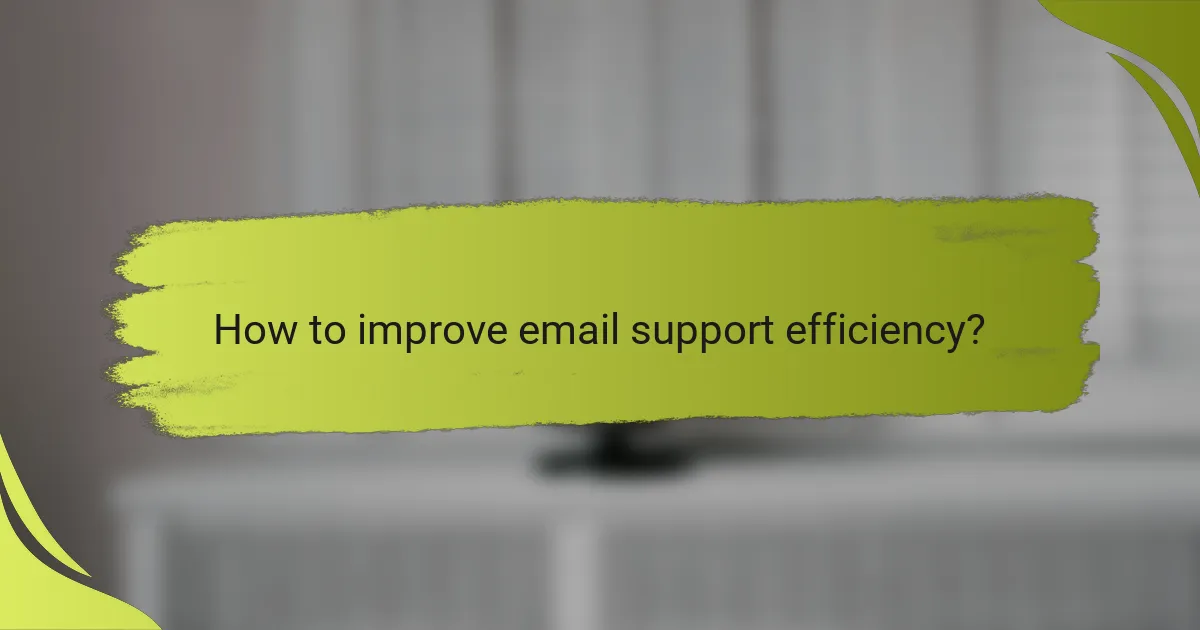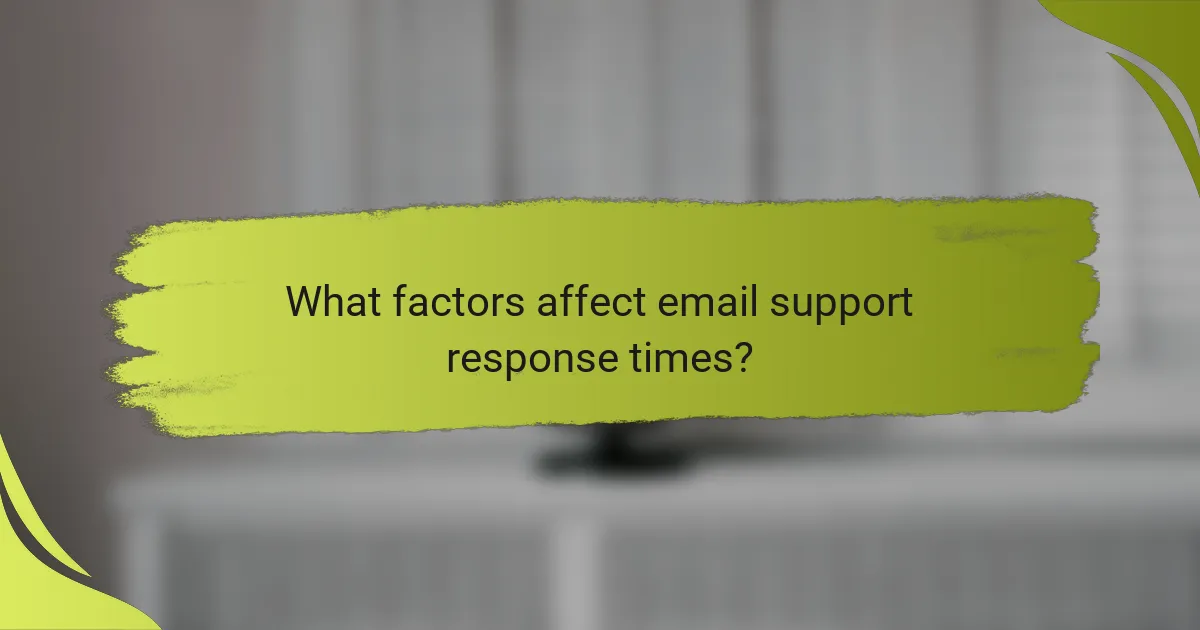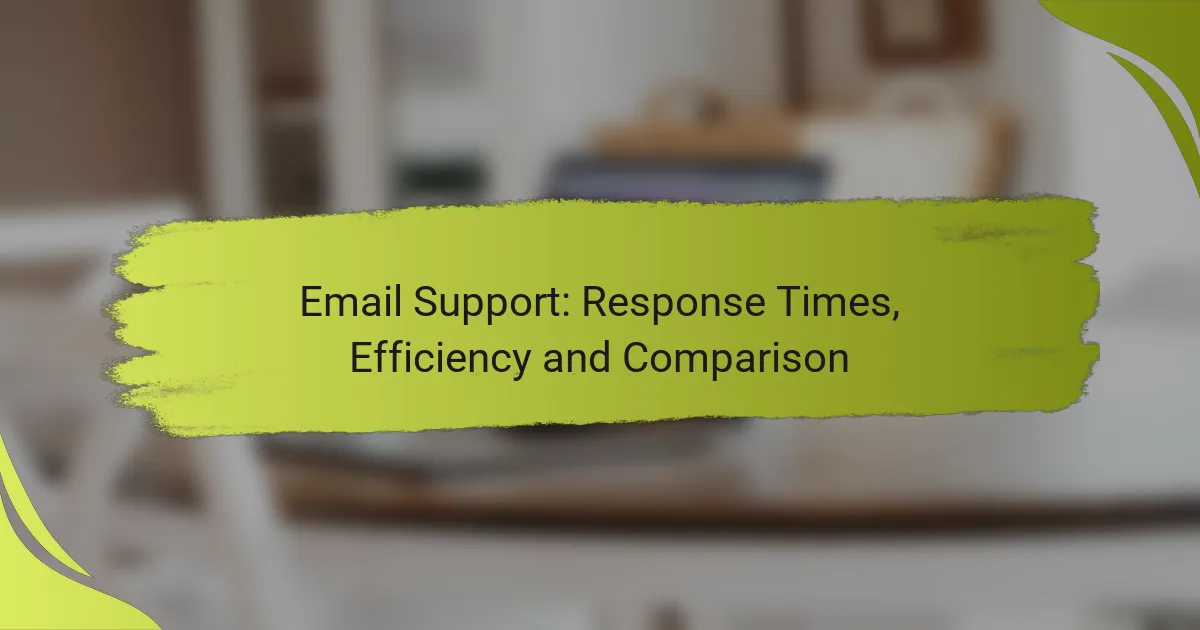Email support response times can vary significantly, often ranging from a few hours to several days depending on factors such as inquiry volume and issue complexity. While email support may not match the immediacy of live chat, it can be more effective for addressing complex issues that require thorough explanations. By enhancing processes and leveraging technology, organizations can improve efficiency and customer satisfaction in their email support systems.

What are the average email support response times in major US cities?
Average email support response times vary across major US cities, typically ranging from a few hours to a couple of days. Factors influencing these times include the volume of inquiries, the complexity of issues, and the resources available to support teams.
New York response time
In New York, email support response times generally range from 1 to 3 hours for basic inquiries. However, more complex issues may take up to 24 hours for a response. Companies often prioritize urgent requests, which can lead to faster resolutions for pressing matters.
Los Angeles response time
Email support in Los Angeles typically sees response times of about 2 to 4 hours for straightforward questions. For more complicated issues, customers may wait between 24 to 48 hours. The city’s diverse business landscape means that response times can vary significantly by industry.
Chicago response time
In Chicago, customers can expect email support responses within 1 to 5 hours for simple inquiries. Complex cases may take longer, often up to 48 hours. Local businesses are increasingly adopting automated systems to improve efficiency and reduce wait times.
Houston response time
Email support response times in Houston usually fall between 2 to 6 hours for basic queries. More detailed inquiries may require 24 to 36 hours for a thorough response. Companies in Houston are focusing on enhancing their customer service capabilities to meet rising expectations.
Philadelphia response time
In Philadelphia, average email support response times are around 1 to 4 hours for straightforward issues. For more intricate problems, the wait can extend to 24 hours. Many businesses are implementing strategies to streamline their email support processes, aiming to improve overall customer satisfaction.

How to improve email support efficiency?
Improving email support efficiency involves streamlining processes, utilizing technology, and enhancing staff capabilities. By focusing on automation, management tools, and training, organizations can significantly reduce response times and improve customer satisfaction.
Implementing automated responses
Automated responses can quickly acknowledge incoming emails, providing customers with immediate confirmation that their inquiries are being addressed. This initial communication can include estimated response times and frequently asked questions to reduce follow-up queries.
Consider setting up templates for common issues, allowing for quick replies that maintain a personal touch. However, ensure that automated messages do not replace genuine human interaction, as customers often prefer personalized responses for complex issues.
Utilizing email management tools
Email management tools can enhance efficiency by organizing incoming messages, prioritizing urgent requests, and tracking response times. Tools like helpdesk software can categorize emails based on keywords or customer history, ensuring that the right team member addresses each issue.
When selecting a management tool, look for features such as analytics dashboards that provide insights into response times and workload distribution. This data can help identify bottlenecks and improve overall support performance.
Training support staff
Training support staff is crucial for improving email support efficiency. Regular training sessions can equip team members with the skills to handle inquiries more effectively and understand the tools at their disposal. Focus on communication skills, problem-solving techniques, and familiarity with the products or services offered.
Encourage staff to share best practices and learn from each other’s experiences. This collaborative approach can lead to faster resolutions and a more cohesive team environment, ultimately benefiting customer interactions.

How does email support compare to live chat support?
Email support typically offers slower response times compared to live chat support, which provides immediate assistance. However, email can be more efficient for complex issues that require detailed explanations or documentation.
Response time comparison
Live chat support usually responds within a few seconds to a couple of minutes, making it ideal for urgent inquiries. In contrast, email support may take several hours to a few days to receive a response, depending on the company’s policies and workload.
For businesses, managing response times effectively is crucial. Setting clear expectations for email responses can help mitigate customer frustration, especially when delays are anticipated.
Customer satisfaction comparison
Customer satisfaction tends to be higher with live chat support due to its immediacy and interactive nature. Users appreciate the ability to ask follow-up questions in real-time, which enhances their experience.
Email support can still achieve high satisfaction rates, particularly when responses are thorough and informative. Companies should focus on clarity and resolution in their email communications to maintain customer trust.
Cost-effectiveness analysis
Email support can be more cost-effective for businesses, as it allows agents to handle multiple inquiries simultaneously. This efficiency can reduce operational costs compared to the one-on-one nature of live chat support.
However, the choice between email and live chat should consider the target audience’s preferences. For businesses with a high volume of urgent inquiries, investing in live chat may yield better customer retention and loyalty in the long run.

What factors affect email support response times?
Email support response times are influenced by several key factors, including the volume of incoming emails, staff availability, and the complexity of inquiries. Understanding these elements can help organizations manage expectations and improve their overall efficiency in handling customer communications.
Volume of incoming emails
The volume of incoming emails directly impacts response times. High email traffic can lead to longer wait times as support teams struggle to manage the influx. For instance, during peak seasons or promotional events, businesses may receive hundreds or thousands of emails daily, which can overwhelm available resources.
To mitigate delays, companies can implement automated responses to acknowledge receipt and provide estimated wait times. This helps set customer expectations while the support team works through the backlog.
Staff availability
Staff availability plays a crucial role in determining how quickly emails are addressed. If a support team is understaffed or if employees are unavailable due to vacations or illness, response times will likely increase. Organizations should aim to maintain adequate staffing levels, especially during busy periods.
Scheduling shifts effectively and cross-training employees can enhance availability. Additionally, using part-time or freelance support staff during peak times can help manage workload without overburdening full-time employees.
Complexity of inquiries
The complexity of inquiries significantly affects how long it takes to respond. Simple questions may be resolved quickly, while more complicated issues can require extensive research or collaboration with other departments. For example, a straightforward billing question might be answered in minutes, whereas a technical issue could take days to resolve.
To improve efficiency, support teams can categorize inquiries based on complexity and prioritize them accordingly. Providing comprehensive FAQs or self-service options can also reduce the number of complex inquiries that require direct support, allowing teams to focus on more challenging cases.

What tools can enhance email support?
Tools that enhance email support streamline communication, improve response times, and boost overall efficiency. By leveraging software solutions, organizations can automate tasks, track interactions, and analyze performance metrics to better serve their customers.
Zendesk features
Zendesk offers a robust suite of features designed to enhance email support. Its ticketing system allows for easy tracking and management of customer inquiries, ensuring that no message goes unanswered. Additionally, the platform provides automation tools that can categorize and prioritize emails based on predefined rules.
Another key feature is the integration with various communication channels, enabling support teams to manage emails alongside chats, calls, and social media messages. This omnichannel approach helps maintain a consistent customer experience and allows agents to respond more efficiently.
Zendesk also includes reporting and analytics tools that provide insights into response times and customer satisfaction. By regularly reviewing these metrics, teams can identify areas for improvement and adjust their strategies accordingly, ensuring they meet customer expectations effectively.
